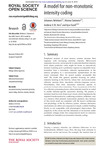Please use this identifier to cite or link to this item:
http://lib.hpu.edu.vn/handle/123456789/21774Full metadata record
| DC Field | Value | Language |
|---|---|---|
| dc.contributor.author | Nehrkorn, Johannes | en_US |
| dc.date.accessioned | 2016-06-25T01:57:28Z | |
| dc.date.available | 2016-06-25T01:57:28Z | |
| dc.date.issued | 2015 | en_US |
| dc.identifier.other | HPU4160269 | en_US |
| dc.identifier.uri | https://lib.hpu.edu.vn/handle/123456789/21774 | en_US |
| dc.description.abstract | Peripheral neurons of most sensory systems increase their response with increasing stimulus intensity. Behavioural responses, however, can be specific to some intermediate intensity level whose particular value might be innate or associatively learned. Learning such a preference requires an adjustable trans-formation from a monotonic stimulus representation at the sensory periphery to a non-monotonic representation for the motor command. | en_US |
| dc.format.extent | 13 p. | en_US |
| dc.format.mimetype | application/pdf | en_US |
| dc.language.iso | en | en_US |
| dc.publisher | The Royal Society | en_US |
| dc.subject | Biology | en_US |
| dc.subject | Behaviour | en_US |
| dc.subject | Neuroscience | en_US |
| dc.title | Amodel for non monotonic intensity coding | en_US |
| dc.type | Book | en_US |
| dc.size | 743KB | en_US |
| dc.department | Education | en_US |
| Appears in Collections: | Education | |
Files in This Item:
| File | Description | Size | Format | |
|---|---|---|---|---|
| 0152_Amodel_for_non_monotonic_intensity_coding.pdf Restricted Access | 743.79 kB | Adobe PDF |  View/Open Request a copy |
Items in DSpace are protected by copyright, with all rights reserved, unless otherwise indicated.
